A delightful array of hummingbirds graces the skies in Missouri, bringing vibrancy and charm to the natural tapestry. The state hosts several hummingbird species, each contributing unique hues and aerial prowess.
From the iconic Ruby-throated Hummingbird to the rare and captivating Rivoli, these tiny avian wonders captivate observers with their dazzling plumage and intricate behaviors.
This compilation unveils 11 enchanting hummingbirds that call Missouri home, detailing their sizes, colors, habitats, and the occasional migratory visits.
Join us on a journey into these iridescent marvels’ miniature world, exploring their diverse landscapes and the conservation efforts essential for preserving their delicate existence in the heart of the Show-Me State. Stay sharp.
11 Hummingbirds in Missouri
Check out the enchanting world of hummingbirds with a glimpse into the lives of these vibrant winged creatures. From the common residents to the rare visitors, each hummingbird species brings its unique charm to the skies.
Delve into their sizes, colors, habitats, and more as we unfold the wonders of nature.
1. Ruby-throated Hummingbird
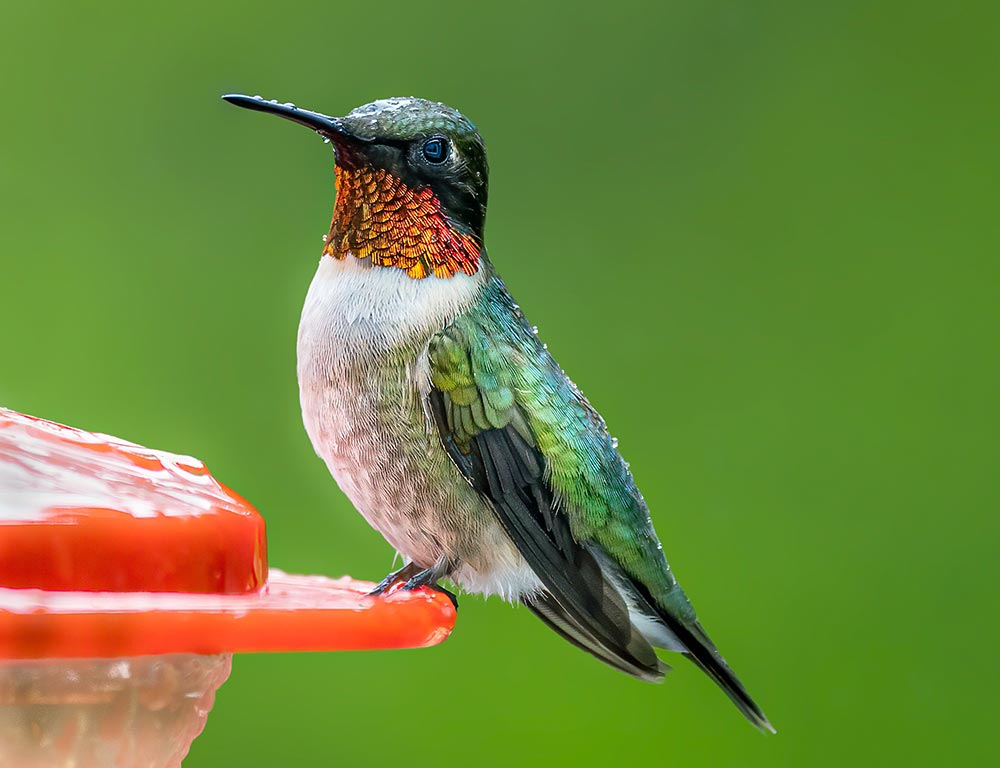
- Scientific name: Archilochus colubris
- Size: 3 to 3.5 inches
- Weight: Approximately 3 grams
- Population: Common and widespread in Missouri
- Life span: 3 to 5 years
- Wingspan: 4 to 4.5 inches
- Status: Stable
The Ruby-throated Hummingbird is the only hummingbird species that breeds in eastern North America, including Missouri.
These tiny birds are known for their vibrant green plumage, and, as the name suggests, the males have a striking iridescent ruby-red throat patch.
They are migratory birds, spending their winters in Central America and Mexico. Ruby-throated Hummingbirds are agile flyers, capable of hovering and rapid maneuvers.
Their diet primarily consists of nectar from flowers, which they obtain using their specialized long bills and extendable, tube-like tongues. They also consume small insects and spiders for protein.
In Missouri, these hummingbirds are attracted to gardens with nectar-rich flowers, and they often use tree branches for perching and as vantage points for defending their territory.
Their nests are typically cup-shaped, constructed with plant materials and spider silk, and camouflaged with lichens.
2. Rufous Hummingbird
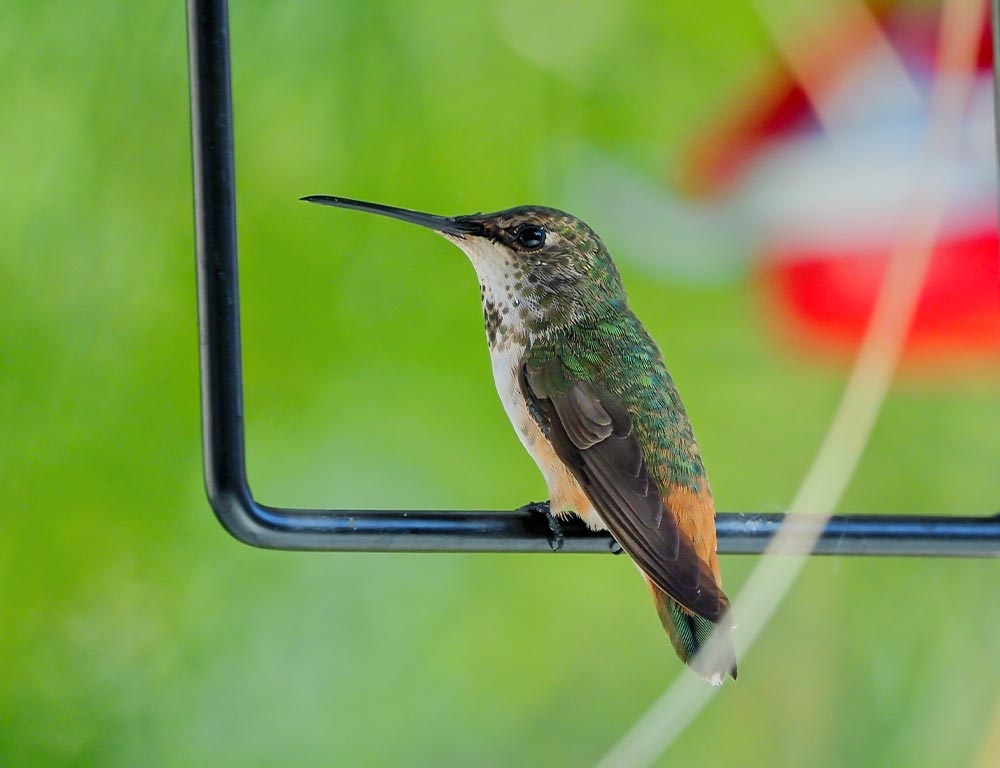
- Scientific name: Selasphorus rufus
- Size: 3.1 to 3.5 inches
- Weight: 2 to 5 grams
- Population: Uncommon in Missouri, primarily seen during migration
- Life span: 3 to 5 years
- Wingspan: 4 to 4.5 inches
- Status: Declining
The Rufous Hummingbird is a western species that occasionally appears in Missouri during migration. They are slightly larger than the Ruby-throated Hummingbird and have a more robust appearance.
The males have an orange-red throat, while the females and immature birds exhibit greenish-gold plumage.
These hummingbirds have an extensive migration route, traveling from their breeding grounds in western North America to their wintering grounds in Mexico.
They are known for their aggressive behavior and may defend feeding territories vigorously. Rufous Hummingbirds feed on nectar from a variety of flowers and also consume insects and spiders.
In Missouri, they can be spotted in gardens with suitable flowers, and their sightings are a treat for birdwatchers due to their less frequent presence in the region.
3. Anna’s Hummingbird
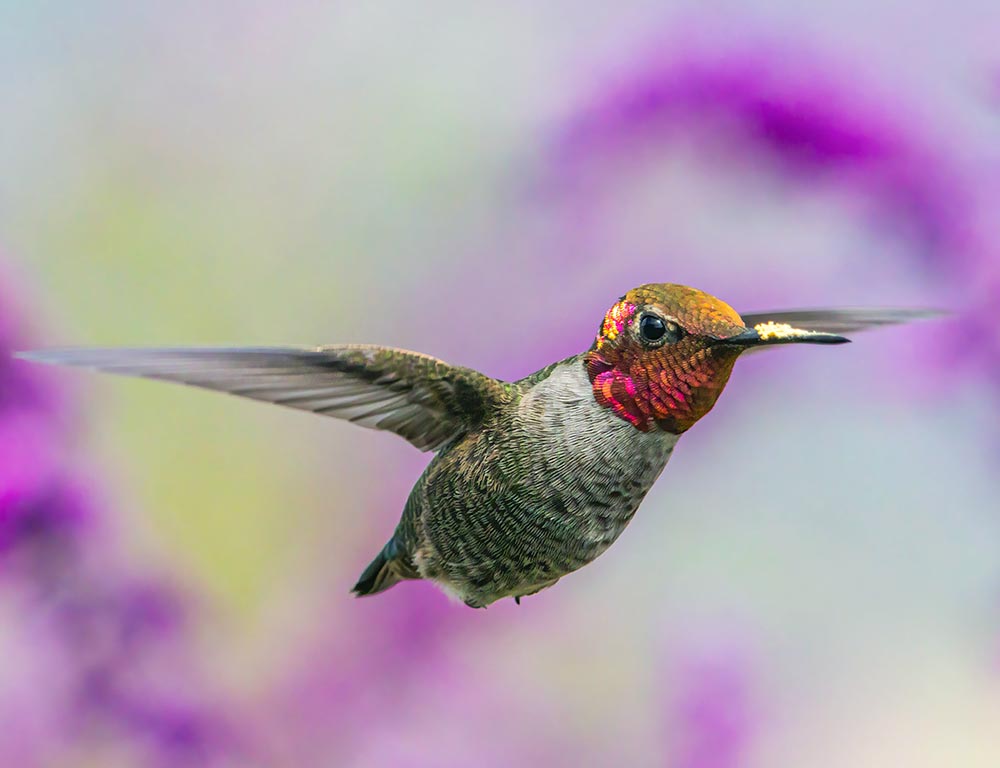
- Scientific name: Calypte anna
- Size: 3.9 to 4.3 inches
- Weight: 3 to 4.5 grams
- Population: Native to western North America, occasionally in Missouri
- Life span: 3 to 5 years
- Wingspan: 4.7 to 5.1 inches
- Status: Stable
Anna’s Hummingbird is primarily found along the western coast of North America but can occasionally be observed in Missouri, particularly during migration.
The males have striking iridescent pink-red throats, while females and juveniles have a more muted coloring. These hummingbirds are known for their year-round presence in their native range.
Anna’s Hummingbirds feed on nectar from various flowers and may also consume insects and spiders.
They are capable of rapid and agile flight and are known to perform impressive aerial displays, including elaborate courtship flights.
In areas where they are more common, such as the Pacific Northwest, Anna’s Hummingbirds are known to nest throughout the year, even in winter.
They construct cup-shaped nests made of plant fibers, spider silk, and down, often in trees or shrubs.
4. Calliope Hummingbird

- Scientific name: Selasphorus calliope
- Size: 2.8 to 3.2 inches
- Weight: 1.6 to 3 grams
- Population: Occasional in Missouri during migration
- Life span: 3 to 5 years
- Wingspan: 3.1 to 4.3 inches
- Status: Least Concern
The Calliope Hummingbird is the smallest bird species in North America and is found primarily in the western mountainous regions.
While not a common resident, they may pass through Missouri during migration. Males have distinctive magenta streaks on their throats, while females and juveniles exhibit greenish plumage.
Calliope Hummingbirds primarily feed on flower nectar and supplement their diet with small insects.
Their migration route can cover thousands of miles, and they are known for their endurance in flight. These hummingbirds often use high-altitude meadows and open woodland habitats.
Nesting occurs in mountainous regions, and their nests are usually placed on the lower branches of coniferous trees. The nests are compact and made from plant down, spider silk, and other fine materials.
5. Black-chinned Hummingbird
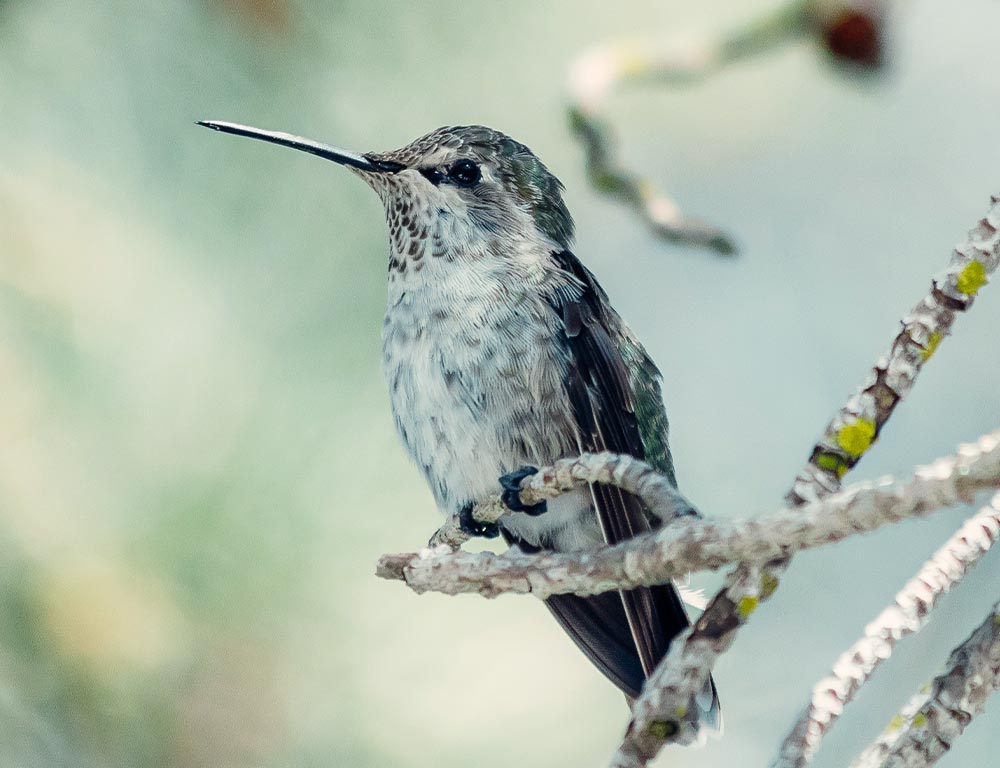
- Scientific name: Archilochus alexandri
- Size: 3.1 to 3.9 inches
- Weight: 2 to 5 grams
- Population: Occasional in Missouri during migration
- Life span: 3 to 5 years
- Wingspan: 4.3 inches
- Status: Stable
The Black-chinned Hummingbird is found in western North America and occasionally ventures into Missouri during migration.
Males have a blackish-purple throat, which can be difficult to see unless the light is just right. Females and juveniles have greenish plumage.
These hummingbirds feed on nectar from various flowers and also consume insects and spiders.
They are agile flyers, capable of hovering and rapid maneuvers. During migration, they may be seen in various habitats, including gardens with suitable nectar sources.
Black-chinned Hummingbirds construct cup-shaped nests made of plant down, feathers, and spider silk, often placed on a horizontal branch.
These birds are known for their adaptability and may use various nesting sites, including shrubs and trees.
Conservation efforts to protect their migratory routes and provide suitable habitats are essential for sustaining their populations.
6. Allen’s Hummingbird
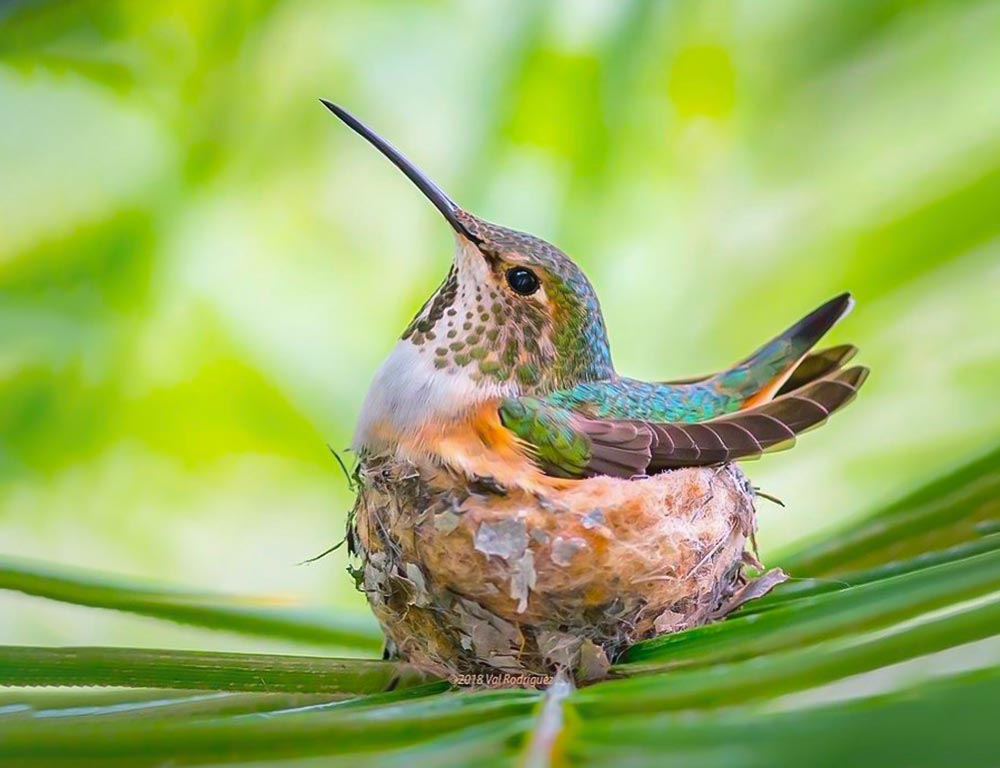
- Scientific name: Selasphorus sasin
- Size: 3.5 to 4 inches
- Weight: 3 to 4 grams
- Population: Native to the western United States, occasionally in Missouri during migration
- Life span: 3 to 5 years
- Wingspan: 4 to 4.5 inches
- Status: Least Concern
Allen’s Hummingbird is primarily found along the western coastal regions of North America, but individuals may occasionally be observed in Missouri during migration.
Males have a vibrant orange-red throat, while females and juveniles display greenish plumage. They are known for their distinctive buzzing vocalizations during courtship displays.
These hummingbirds feed on flower nectar and also consume small insects. They are agile fliers, capable of rapid and intricate maneuvers, and are often seen in a variety of habitats, including gardens with suitable flowers.
Allen’s Hummingbirds construct cup-shaped nests made of plant down, feathers, and spider silk, typically placed on a horizontal branch.
7. Broad-tailed Hummingbird
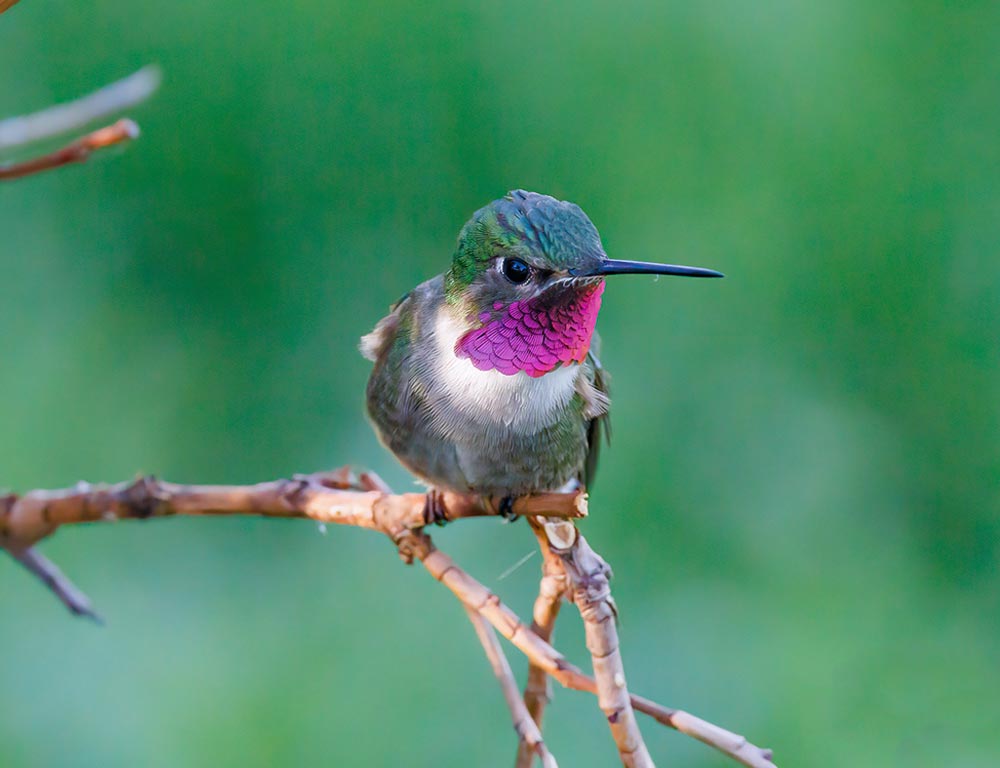
- Scientific name: Selasphorus platycercus
- Size: 3.1 to 3.5 inches
- Weight: 3 to 5 grams
- Population: Native to western North America, migratory, may pass through Missouri
- Life span: 3 to 5 years
- Wingspan: 4.3 inches
- Status: Least Concern
Broad-tailed Hummingbirds are found in mountainous regions of western North America and may pass through Missouri during migration.
Males have a vibrant rose-red throat and are known for their distinctive metallic trilling sound during flight. Females and juveniles have greenish plumage.
These hummingbirds primarily feed on flower nectar and may also consume insects. They are well-adapted to higher elevations and are often found in coniferous forests and meadows.
Broad-tailed Hummingbirds construct cup-shaped nests made of plant fibers, spider silk, and down, often placed on a horizontal branch.
8. Mexican Violetear
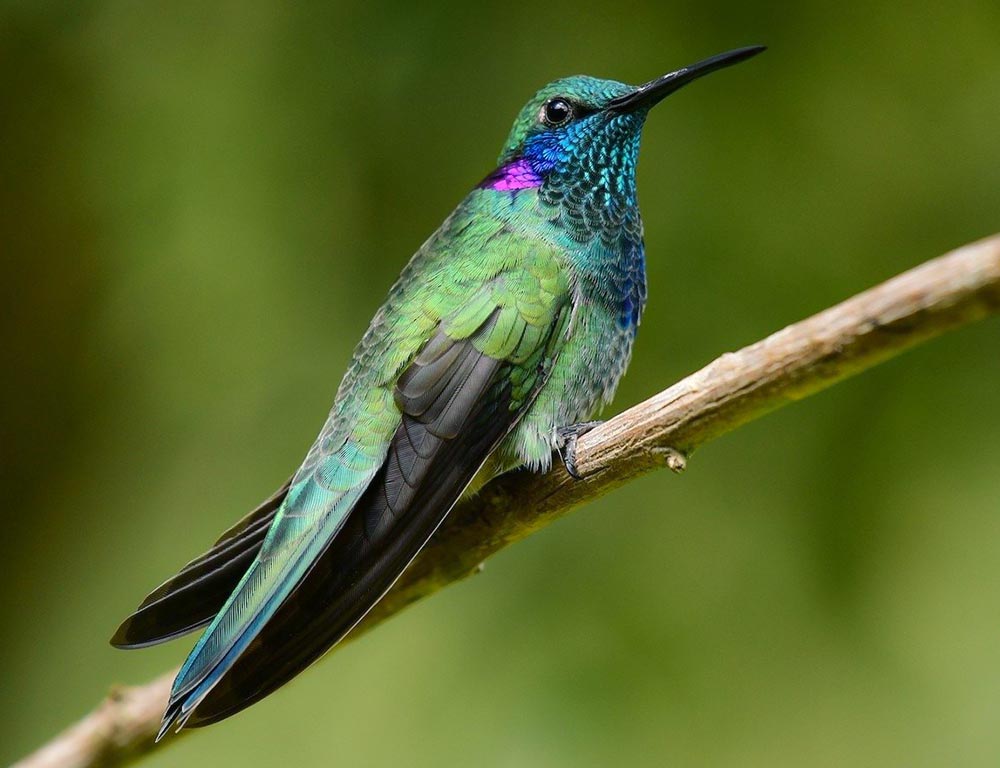
- Scientific name: Colibri thalassinus
- Size: 4.3 to 4.7 inches
- Weight: 5 to 10 grams
- Population: Native to Mexico and Central America, occasional in the southwestern United States, rare in Missouri
- Life span: Up to 6 years
- Wingspan: 6 to 7 inches
- Status: Least Concern
The Mexican Violetear is a larger hummingbird species, and while rare, individuals may be observed in Missouri, particularly in the southwestern parts, during migration.
They are known for their striking iridescent violet-blue ear patches. Mexican Violetears feed on nectar from various flowers and may also consume small insects.
They are often found in mountainous regions and cloud forests. Nests are usually placed on a horizontal branch and constructed with plant fibers and down, often camouflaged with lichens.
9. Rivoli’s Hummingbird
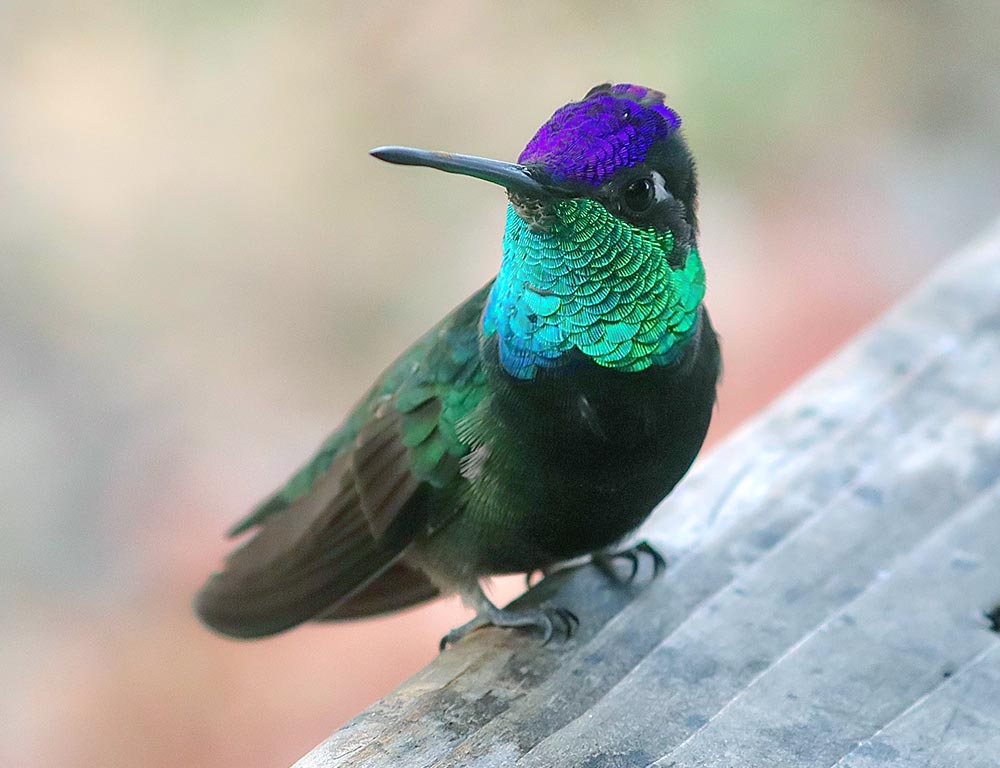
- Scientific name: Eugenes fulgens
- Size: 4 to 5 inches
- Weight: 8 to 12 grams
- Population: Native to western Mexico, rare visitor to the southwestern United States, very rare in Missouri
- Life span: Around 3 to 5 years
- Wingspan: Approximately 5 inches
- Status: Least Concern
Rivoli’s Hummingbird, formerly known as the Magnificent Hummingbird, is native to western Mexico and is a rare visitor to the southwestern United States.
Observations in Missouri would be extremely uncommon. Males are known for their vibrant iridescent green and blue plumage with a contrasting violet crown.
These hummingbirds feed on flower nectar, particularly favoring tubular flowers. They are often found in montane forests and cloud forests at higher elevations.
Nests are constructed on horizontal branches and are made of plant fibers, moss, and down. Conservation efforts should focus on preserving their native habitats, particularly in Mexico, where they are more common.
10. Broad-billed Hummingbird
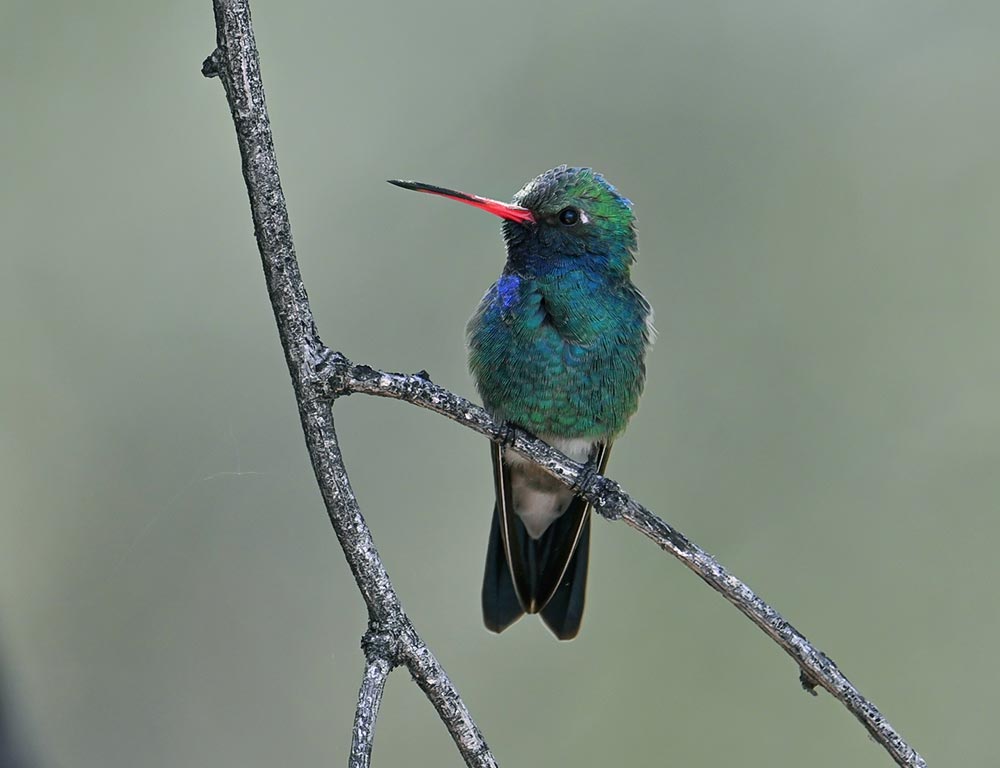
- Scientific name: Cynanthus latirostris
- Size: 3.1 to 3.5 inches
- Weight: 2 to 4 grams
- Population: Resident in the southwestern United States and Mexico, rare in Missouri
- Life span: Around 3 to 5 years
- Wingspan: Approximately 4 inches
- Status: Least Concern
Broad-billed Hummingbirds are native to the southwestern United States and Mexico, with occasional sightings in Missouri.
Males are known for their distinctive, broad, and straight bills and vibrant plumage, including a brilliant red bill and metallic green body.
These hummingbirds primarily feed on nectar from various flowers and may also consume insects.
They are often found in arid and semi-arid habitats, deserts, and scrublands. Nests are cup-shaped and constructed with plant fibers, spider silk, and down.
To support Broad-billed Hummingbirds, efforts should be made to provide suitable flowering plants and maintain habitat diversity in their range.
11. Blue-throated Mountaingem
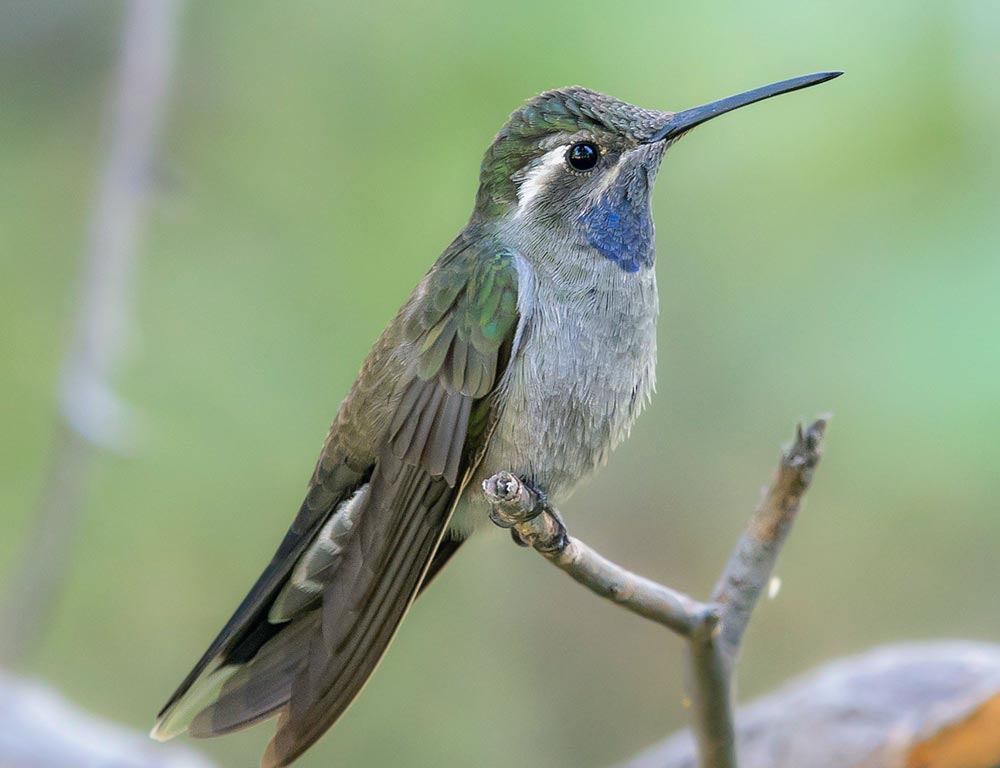
- Scientific name: Lampornis clemenciae
- Size: 4.3 to 5.1 inches
- Weight: 8 to 12 grams
- Population: Native to Mexico and the southwestern United States, rare in Missouri
- Life span: Around 3 to 5 years
- Wingspan: Approximately 6.3 inches
- Status: Least Concern
The Blue-throated Mountaingem is the largest hummingbird in the United States.
Males have a distinctive blue throat, and both males and females display green and white plumage. While rare, sightings in Missouri may occur during migration.
These hummingbirds feed on nectar from various flowers, favoring those with tubular shapes.
They are often found in pine-oak and pine-fir forests at higher elevations. Nests are typically built on horizontal branches and constructed with plant fibers, spider silk, and down.
Conservation efforts should focus on protecting their habitats, particularly in the mountainous regions where they are more commonly found. Providing suitable nectar sources is also important for their well-being.
It’s important to note that conservation efforts are crucial to support hummingbird populations, especially for species facing declining numbers.
Providing food sources, such as nectar-rich flowers and feeders, can contribute to the well-being of these fascinating birds.
Wrapping Up
In the diverse tapestry of Missouri’s ecosystems, hummingbirds add a touch of brilliance. From the familiar Ruby-throated to the rare Rivoli, these enchanting birds captivate with their vibrant hues and aerial acrobatics.
Nurturing these delicate wonders involves understanding their unique traits and preserving their habitats. Conservation efforts play a pivotal role in ensuring the continued dance of hummingbirds across Missouri’s landscapes.
Whether in gardens, mountain meadows, or during migration, these tiny creatures contribute to the rich biodiversity, underscoring the importance of harmonizing human activities with nature.
As stewards of our environment, let us appreciate and safeguard the delicate beauty of hummingbirds for generations to come. Best of luck.